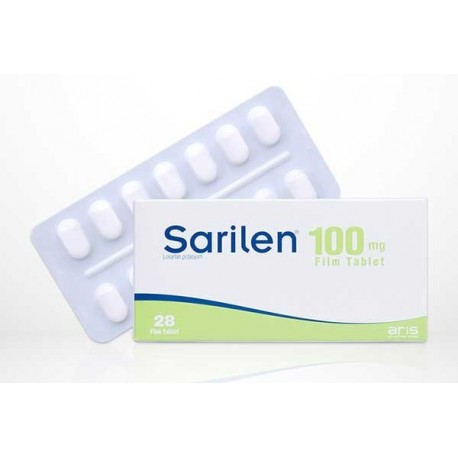 View larger
View larger Sarilen Losartan (Generic Cozaar) 100 Mg 28 Tablets
SRL3007
New product
BUY MORE PAY LESS
| Quantity | Discount | |
|---|---|---|
| 2 | 5% | |
| 3 | 10% | |
| 4 | 15% | |
| 5 | 20% |
Volume discounts
| Quantity | Discount | You Save |
|---|---|---|
| 2 | 5% | Up to $3.40 |
| 3 | 10% | Up to $10.20 |
| 4 | 15% | Up to $20.40 |
| 5 | 20% | Up to $34.00 |
More info
INSTRUCTION MANUAL
SARILEN (Generic Cozaar) 50 mg Film Coated Tablet It is taken orally.
Active ingredient
Each tablet contains 50 mg of losartan.
Excipients
:
Lactose - Tablettose, Avicel pH 102, Snowflake, Croscarmellose sodium, Magnesium stearate Film CoatingOpadry Y-1-7000
1. What is SARILEN (Generic Cozaar) and what is it used for?
Losartan belongs to the group of medicines known as angiotensin-II receptor antagonists.
Angiotensin-II is a substance produced in the body that binds receptors in blood vessels, resulting in increased blood pressure. Losartan prevents binding and reduces pressure by relaxing blood flow.
Losartan slows the decline of kidney function in patients with high blood pressure and type 2 diabetes.
CARILEN (Generic Cozaar) contains 50 mg of losartan. It is presented in blister pack containing 28 tablets.
SARILEN (Generic Cozaar) is used in the following situations.
• It is used in the treatment of patients with high blood pressure (hypertension),
• It is used to reduce the risk of stroke (stroke) in patients with hypertension and thickened left chamber of the heart (left ventricular hypertrophy),
• It is used in hypertensive patients with type 2 diabetes who have renal dysfunction and proteinuria 0.5 g or more (abnormal protein content in the urine).
2. How to use SARILEN (Generic Cozaar)?
Instructions for proper use and dose/frequency of administration
Instructions for:
• Always use SARILEN (Generic Cozaar) as recommended by your doctor.
Your doctor will decide the appropriate dose of SARILEN (Generic Cozaar) according to your disease and other drugs you use.
• It is important that you continue to take SARILEN (Generic Cozaar) for as long as prescribed by your doctor to ensure that your blood pressure stays properly.
• Treatment is usually started with one tablet (50 mg losartan) per day. The drug's greatest blood pressure lowering effect is achieved 3 to 6 weeks after the start of treatment. In some patients, it may be necessary to increase to two tablets (100 mg of losartan) per day.
SARILEN (Generic Cozaar), in combination with other blood pressure lowering drugs (e.g. diuretics, calcium channel blockers, alpha - beta blockers), as well as insulin and other drugs commonly used to lower blood glucose (e.g. sulfonylurea, glitazone and glucosidase inhibitors) can be taken together.
Application route and method
• CARILEN (Generic Cozaar) is for oral use only.
• It can be taken on an empty stomach or with food.
• Take the tablets with a sufficient amount of liquid (eg with a glass of water) without chewing.
• Taking your tablets at the same time every day will give you the best effect on your blood pressure and will also help you remember when to take the tablets.
3. What are the possible side effects?
Like all medicines, there may be side effects in people who are sensitive to the substances contained in SARILEN (Generic Cozaar).
If any of the following occur, stop using SARILEN (Generic Cozaar) and IMMEDIATELY inform your doctor or go to the nearest hospital emergency department:
Severe allergic reaction (rash, itching, swelling of the face, lips, or mouth or
swelling of the throat that makes it difficult to swallow or breathe.
This is a very serious side effect. You need emergency medical attention or hospitalization
it could be. This very serious side effect is rare.
The reported side effects are as follows according to their frequency of occurrence;
Common (less than 1 in 10 patients, but more than 1 in 100 patients):
• dizziness,
• low blood pressure,
• weakness,
• tiredness,
• excessive decrease in blood sugar (hypoglycemia),
• increased level of potassium in the blood (hyperkalemia)
Uncommon (affects less than 1 in 100 patients, but more than 1 in 1000 patients):
• insomnia,
• headache,
• sleeping disorders,
• feeling of increased heart rate,
• severe chest pain,
• low blood pressure (especially after the body is dehydrated),
• Postural disorders (when you stand up) with a decrease in blood pressure
• feeling dizzy),
• intermittent breathing,
• stomach ache,
• defecation problem (obstipation),
• diarrhea,
• nausea,
• vomiting,
• hives,
• itching,
• rash,
• regional swelling (edema)
Rare (affects less than 1 in 1,000 patients, but more than 1 in 10,000):
• vascular inflammation (vasculitis including Henoch-Schonlein purpura),
• fainting,
• liver inflammation (hepatitis),
• elevation of alanine aminotransferase (ALT) in the blood (usually resolved with discontinuation of treatment)
Not known (frequency cannot be estimated from the available data):
• anemia (anemia),
• decrease in platelet count,
• migraine,
• cough,
• abnormal liver function,
• muscle and joint pain,
• changes in kidney function, including renal failure (reversible with treatment discontinuation),
• flu-like symptoms,
• increased blood-urea level,
• back pain,
• urinary tract inflammation.

